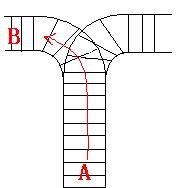标签:



3 123 321 3 123 312
Yes. in in in out out out FINISH No. FINISHFor the first Sample Input, we let train 1 get in, then train 2 and train 3. So now train 3 is at the top of the railway, so train 3 can leave first, then train 2 and train 1. In the second Sample input, we should let train 3 leave first, so we have to let train 1 get in, then train 2 and train 3. Now we can let train 3 leave. But after that we can‘t let train 1 leave before train 2, because train 2 is at the top of the railway at the moment. So we output "No.".HintHint
栈的简单应用,本题详细解答在白书上有.
下面附上代码:用c++交会错,用G++就不会。。。求解释
#include<iostream>
#include<stack>
#include<cstring>
#include<cstdio>
using namespace std;
int a[10000],ans[20000],b[10000];
stack<int>ss;
int main()
{
int n,i,j,k;
string s1,s2;
while(scanf("%d",&n)!=EOF){
cin>>s1>>s2;
for(i=1;i<=n;i++) a[i]=s1[i-1]-'0';
for(j=1;j<=n;j++) b[j]=s2[j-1]-'0';
while(!ss.empty()) ss.pop();
k=0,j=1;
for(i=1;i<=n;i++) {
ss.push(a[i]);
ans[++k]=1;
while(!ss.empty() && ss.top()==b[j]) {
ss.pop();
ans[++k]=2;
j++;
}
}
if(k==2*n) {
printf("Yes.\n");
for(i=1;i<=2*n;i++) {
if(ans[i]==1) printf("in\n");
else printf("out\n");
}
}
else printf("No.\n");
printf("FINISH\n");
}
return 0;
}
版权声明:本文为博主原创文章,未经博主允许不得转载。
标签:
原文地址:http://blog.csdn.net/h1021456873/article/details/47680997